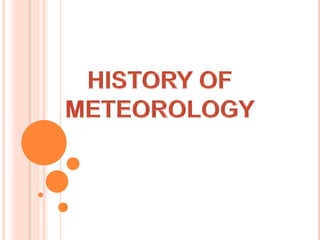
History of meteorology
- 2. The word 'meteorology' was coined from a research book called 'Meteorologica' which was written by Aristotle, a Greek scientist and philosopher. This early work described the science of earth like its geology, elements, hydrology, seas, wind and weather. In the modern term, the term meteorology explains a complete science. It is for understanding the dynamics of atmosphere and forecasting weather phenomena like hurricanes and thunderstorms.
- 3. Weather forecasting was practiced since the beginning of time with more or less accuracy. Historical records show several examples of weather predicting methods based on observing surrounding elements. Sky is undoubtedly the first indicator used in meteorology its cover and nature of clouds provides clues of the upcoming temperature and weather. The wind factor is also important and is associated with temperature and often rains. Animals and birds are also known to give indications about the future weather.
- 4. Scientists across the world since ancient times have tried to understand the meteorological phenomena like wind and rain. Many instruments for measuring wind power, humidity and rain were invented in the early 15th century. During the 17th century, several discoveries tipped in favor of scientific meteorology. A device to measure temperature was invented by Galileo Galilei and the factor that atmospheric pressure was linked to altitude was discovered by Blaise Pascal. The invention of barometer by Evangelista Torricelli is significantly the most important discovery. It is still in use today which indicates atmospheric pressure changes that are linked with the future weather changes.
- 5. There are also other methods which have been evolved. Meteorology is a lot related with cycles and their analysis which was what Fernando II de Medici wanted to prove. He carried out a very determined program in 1654 for recording weather patterns in different European cities with a view to compile data and make their analysis. Other breakthroughs were followed in the 18th century and science was taken to a new level. A modern mercury based thermometer was invented by Gabriel Fahrenheit. Theories about hydrodynamics were devised by Daniel Bernoulli and those theories had helped greatly in understanding the atmospheric changes.
- 6. When the theory of thermodynamics and atmospheric pressures were adapted, no real changes were important for understanding meteorology. In recent times, focus has been given on meteorological tools for its improvement and attaining better accuracy results. A tremendous boost was given to meteorology because of the technology in two ways. The first is the ability to communicate results and analysis with timing, it was made possible due to the invention of telegraph. The second is the ability of probing skies with using balloons, satellites and radars.
- 7. Meteorology is a part of our everyday lives. People are kept updated about the changing weather with dedicated channels and mobile devices. The science is still progressing and is an important element of the economy with many industries like agriculture and civil aviation depending on it.
- 8. Invention of weather instrument Measuring the Weather In the early days of the Weather Bureau numerous clever mechanical devices were invented to measure and record any and every meteorological (weather) parameter conceivable: ombroscope or rainfall recorder, mechanical anemometer or wind speed indicator, remote readout wind vane, pole star recorder. Anemometer Wind velocity or speed is measured by a cup anemometer, an instrument with three or four small hollow metal hemispheres set so that they catch the wind and revolve about a vertical rod. An electrical device records the revolutions of the cups and calculates the wind velocity. The word anemometer comes from the Greek word for wind, "anemos."
- 9. Barometer Barometer - Pronunciation: [b u rom´ u t u r] - a barometer is an instrument for measuring atmospheric pressure. The barometer was invented by Evangelista Torricelli in 1643. Hygrometer A hygrometer is an instrument used to measure the moisture content or the humidity of air or any gas.Rain Gauge A rain gauge measures how much rain has fallen.Thermometer Thermometers measure temperature by using materials that change in some way when they are heated or cooled. The first thermometers were called thermoscopes, and while several inventors invented a version of the thermoscope at the same time, Italian inventor SantorioSantorio was the first inventor to put a numerical scale on the instrument. In 1724, Gabriel Fahrenheit invented the first mercury thermometer.